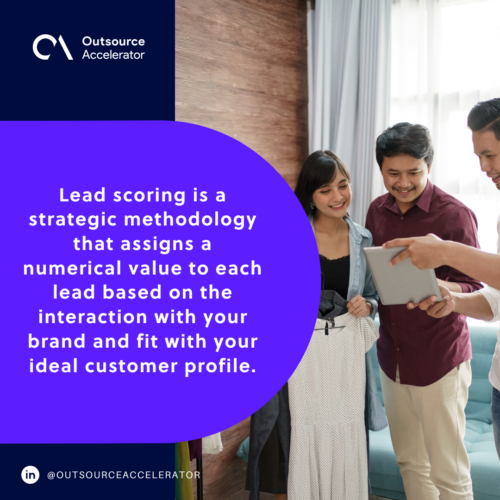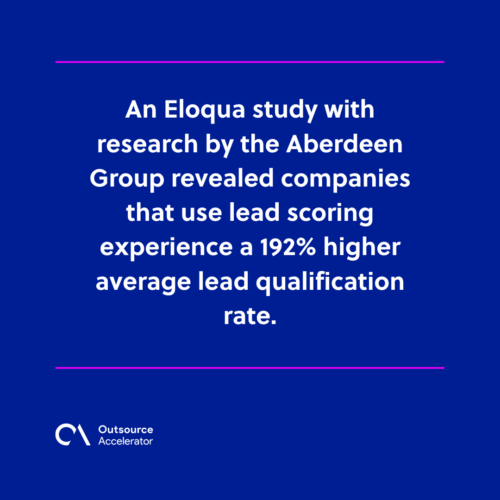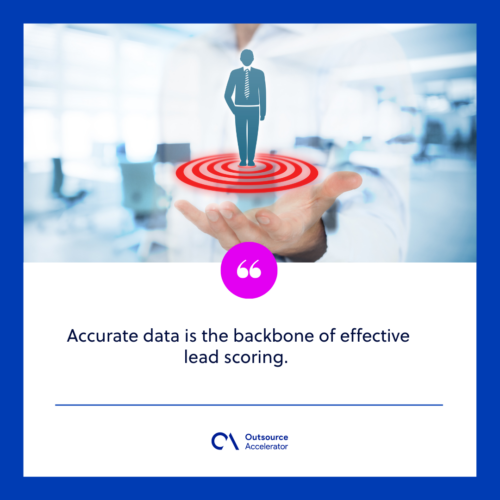Lead scoring 101: Understanding the science behind effective lead evaluation

In business, the quest for potential customers is a perpetual endeavor. While the digital landscape offers a plethora of opportunities, the key lies in identifying the most promising leads.
This is where lead scoring steps in — a methodical approach that separates the high-potential and less promising, guiding your efforts toward the most valuable prospects.
Learn more about lead scoring and how it can help your business’s lead generation efforts.
What is lead scoring?
Lead scoring is a strategic methodology that assigns a numerical value to each lead based on the interaction with your brand and fit with your ideal customer profile.
This process streamlines your marketing and sales efforts. It also lets you focus your resources on leads more likely to convert into paying customers.
Statistics gathered by Abdalslam show lead scoring is the best way to prioritize leads. That’s why 63% of companies use this approach to manage their prospects.

How do you score a lead?
Scoring a lead involves assessing two crucial dimensions: engagement and fit.
Engagement refers to the lead’s level of interaction with your brand. This includes website visits, downloads, email opens, and social media interactions.
Conversely, fit pertains to how closely the lead aligns with your target customer characteristics. This can include factors like industry, company size, job role, and geographic location.
To put this into perspective, consider a software company. A lead who has visited its website, downloaded a whitepaper, and interacted with the firm’s social media posts showcases high engagement.
If this lead also fits the ideal customer profile by working in a relevant industry, its fit score would be equally high.
Combining these engagement and fit scores provides a holistic view of the lead’s potential value.
Why is lead scoring important?
Lead scoring plays a vital role in optimizing a business’ sales and marketing efforts.
Resources can be allocated more efficiently and effectively by prioritizing leads based on their conversion likelihood.
Instead of wasting time and energy on prospects unlikely to convert, brands can focus on nurturing and engaging with high-quality leads more likely to result in a sale.
This targeted approach helps businesses streamline their sales process, increase conversion rates, and drive revenue growth.
An Eloqua study with research by the Aberdeen Group revealed companies that use lead scoring experience a 192% higher average lead qualification rate.

Lead scoring models
Businesses can adopt various lead scoring models depending on their needs and goals. Here are some common approaches:
Explicit scoring
Explicit scoring assigns scores based on explicit actions taken by the lead.
Examples of this model include:
- Filling out a contact form
- Requesting a quote
- Subscribing to a newsletter
These actions would indicate a higher level of interest and intent to purchase.
Implicit scoring
Implicit scoring focuses on implicit actions and behaviors exhibited by leads.
It involves tracking and analyzing digital footprints, such as:
- Website browsing behavior
- Social media interactions
- Content consumption patterns
Leads exhibiting strong engagement and interest receive higher scores.
Negative scoring
Negative scoring deducts points from leads that exhibit undesirable behaviors or characteristics.
For instance, if a prospect consistently unsubscribes from emails or has a history of poor engagement, their score may be reduced to reflect their lower likelihood of conversion.
Predictive scoring
Predictive scoring uses advanced analytics to assign scores based on a lead’s likelihood to convert.
It considers historical data, behavioral patterns, and other variables to generate a predictive score. This model helps businesses identify leads with the highest potential for conversion.
Purchase intent model
The purchase intent model focuses on assessing the intent of a lead to make a purchase. It combines explicit and implicit behavior data to determine how likely they are to make a buying decision within a specific timeframe.
Leads indicating a high purchase intent receive higher scores.
Firmographic/demographic model
This model assigns scores based on firmographic and demographic data.
It takes into account factors such as:
- Company size
- Industry
- Job title
- Geographic location
These considerations gauge the potential fit of a lead with the business’s target market.
Score degradation
Over time, the relevance and accuracy of lead scores may diminish. Score degradation addresses this issue by reducing the score of leads that have been inactive or disengaged for a certain period.
This ensures that effort and resources can be focused on leads actively showing interest and engagement.
What to consider before implementing lead scoring models
Before diving into lead scoring, it’s essential to consider a few key factors:
- Data quality. Accurate data is the backbone of effective lead scoring. Ensure your data is clean, updated, and consistent.
- Collaboration. Establish a seamless collaboration between your marketing and sales teams. Define what constitutes a sales qualified lead (SQL) and a marketing qualified lead (MQL).
- Scoring criteria. Clearly define the criteria for engagement and fit that align with your business objectives.
- Continuous refinement. Lead scoring is not a one-time task. Regularly review and adjust your scoring criteria based on real-world feedback and changing customer behavior.

Lead scoring best practices
To better harness the power of lead scoring, adhere to these best practices:
- Maintain alignment between your scoring criteria and your business objectives. Regularly revisit and refine your scoring model to ensure relevance.
- Segment your leads based on their scores. Tailor your marketing and sales approaches to cater to the unique needs of each segment.
- Continuously test and optimize your scoring criteria. Experiment with different weights for engagement and fit to find the most effective combination.
- Establish a feedback loop between marketing and sales to assess the quality of leads that convert into customers. This feedback informs adjustments to your scoring model.
- Consider implementing an automated lead scoring system that can analyze large volumes of data, apply scoring criteria consistently, and provide real-time insights.
- Pay close attention to how leads progress through the sales funnel. You can identify patterns and fine-tune your lead scoring model by tracking how scoring aligns with conversions.







 Independent
Independent




